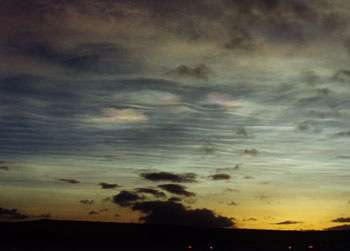 by Doug Schneider March 05, 2005
It can get really cold in the Arctic, especially in the layer of the upper Arctic atmosphere called the stratosphere. That's the relatively thin layer about 36 to 50 miles above the earth that contains ozone. Ozone is important because it blocks the sun's harmful ultraviolet rays from reaching the earth where they can cause skin cancer and other ailments. But when the stratosphere becomes too cold, like this year, when in January temperatures plummeted to more than 125 degrees below zero, chemicals in the layer, such as nitrogen and chlorine, freeze and form polar stratospheric clouds. It's within these thin, wispy clouds that a complex chemical chain reaction occurs to destroy ozone. Paul Newman is an atmospheric physicist with NASA's Goddard Space Flight Center in Greenbelt, Maryland. He says conditions are shaping up for what may be a significant loss of ozone in the weeks ahead. Newman said, "It should be a good ozone loss year, but it hasn't quite happened yet. We will know more when we go into March. We are still a few weeks away from knowing how things are going to evolve." For much of the winter, the high Arctic has been cloaked in darkness. But Newman says the high Arctic has begun to receive the final ingredient needed to destroy ozone-sunlight. Sunlight is the catalyst that drives the chemical reactions that break down ozone. Adding to the problem are industrial chemicals such as chlorine and chlorofluorocarbons, or CFCs, that make their way in to the Arctic stratosphere. Although CFCs are banned in many countries, including the United States, they are still used elsewhere. Cathy Cahill is an atmospheric scientist at the University of Alaska Fairbanks. She says CFCs contain the chemicals that destroy ozone. Cahill said, "Chlorofluorocarbon is a compound that has chlorine and fluorine. And when it hits the stratosphere, the sunlight breaks it apart and releases chlorine atoms. Which will then cycle and destroy ozone." Almost every year, conditions occur in the Arctic that destroy at least some ozone. But some years, a great deal of ozone is lost. In 2000, a record amount of ozone was lost over Greenland, England and northern Europe. In 1997, an area of ozone the size of Texas thinned over the Russian high Arctic. But just as the sun triggers the destruction of ozone, it also helps create it. Sunlight in the warmer mid- and lower latitudes cause another chemical reaction that produces ozone. The ozone is carried to the poles on upper atmosphere wind currents, where it replenishes the protective ozone layer. Scientists predict that most of this year's ozone losses will occur over northern Europe. Experts there are keeping a close eye on things, and getting ready to warn people to wear sunglasses and sun block to prevent skin cancer. The ozone layer is not expected to become thinner over other parts of the Arctic, such as Canada and Alaska.
This story is courtesy of Arctic Science Journeys. ASJ is a radio service highlighting science, culture, and the environment of the circumpolar north. Produced by the Alaska Sea Grant College Program and the University of Alaska Fairbanks.
|
|||
